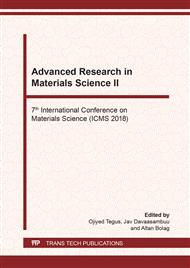[1]
N.V. Thang, X.F. Miao, N.H.V. Dijk, et al. Structural and magnetocaloric properties of (Mn,Fe)2(P,Si) materials with added nitrogen[J]. J. Alloy. Compd., 2016, 670, 123-127.
DOI: 10.1016/j.jallcom.2016.02.014
Google Scholar
[2]
J. Tusek, S. Zupan, Zupan, et al. Magnetic cooling-development of magnetic refrigerator[J]. Stroj. Vestn-J Mech E, 2009, 55(5), 293-302.
Google Scholar
[3]
G.V. Brown. Magnetic heat pumping near room temperature[J]. J. Appl. Phys., 1976, 47(8), 3673-3680.
Google Scholar
[4]
J.W. Cable, E.O. Wollan. Neutron diffraction study of the magnetic behavior of gadolinium[J]. Phys. Rev., 1968, 165(2), 733-734.
DOI: 10.1103/physrev.165.733
Google Scholar
[5]
S.A. Nikitin, A.S. Andreenko, N.P. Arutyunyan, et al. Spin reorientation in a magnetic field parallel to the difficult magnetization axis in terbium-gadolinium alloys[J]. Sov. Phys. -Solid State (Engl. Transl.); (United States), 1978, 20:12.
Google Scholar
[6]
H. Wada, Y. Tanabe. Giant magnetocaloric effect of MnAs1-xSbx[J]. Appl. Phys. Lett., 2001, 79(20), 3302-3304.
DOI: 10.1063/1.1419048
Google Scholar
[7]
H. Wada, T. Morikawa, K. Taniguchi, et al. Giant magnetocaloric effect of MnAs1− xSb x, in the vicinity of first-order magnetic transition[J]. Physica. B, 2003, 328(1–2), 114-116.
DOI: 10.1016/s0921-4526(02)01822-7
Google Scholar
[8]
J. Liu, T. Gottschall, K.P. Skokov, et al. Giant magnetocaloric effect driven by structural transitions[J]. Nature Mater., 2012, 11(7), 620.
DOI: 10.1038/nmat3334
Google Scholar
[9]
Hu Fengxia, Shen Baogen, Sun Jirong, et al. Influence of negative lattice expansion and metamagnetic transition on magnetic entropy change in the compound LaFe11.4Si1.6[J]. Appl. Phys. Lett., 2001, 78(23), 3675-3677.
DOI: 10.1063/1.1375836
Google Scholar
[10]
S. Fujieda, A. Fujita, K. Fukamichi. Large magnetocaloric effect in La(FexSi1-x)13 itinerant-electron metamagnetic compounds [J] . Appl. Phys. Lett., 2002, 81(7), 1276-1278.
DOI: 10.1063/1.1498148
Google Scholar
[11]
O. Tegus, E. Brück, K.H.J. Buschow, et al. Transition-metal-based magnetic refrigerants for room-temperature applications[J]. Nature, 2002, 415, 150-153.
DOI: 10.1038/415150a
Google Scholar
[12]
O. Tegus, E. Brück, W. Dagula, et al. Magnetoresistance of MnFeP0.55As0.45[J]. IEEE T. Magn., 2002, 38(5), 2753-2754.
Google Scholar
[13]
L. Zhang. Unusual magnetic behavior of some rare-earth and manganese compounds[D]. University of Amsterdam: Amsterdam, (2005).
Google Scholar
[14]
O. Tegus, B. Fuquan, W. Dagula, et al. Magnetic-entropy change in Mn1.1Fe0.9P0.7As0.3–x Gex[J]. J. Alloy. Compd., 2005, 36(36), 6-9.
Google Scholar
[15]
W. Dagula, O. Tegus, B. Fuquan, et al. Magnetic entropy change in Mn1.1Fe0.9P1-xGex compounds[C]. IEEE T. Magn., 2005, 1805-1806.
Google Scholar
[16]
D.T.C. Thanh, E. Brück, et al. Structure, magnetism and magnetocaloric properties of MnFeP1-xSix [J]. J. Appl. Phys., 2008, 103, 07B318.
DOI: 10.1063/1.2836958
Google Scholar
[17]
O. Hascholu, S. Zhiqiang, L. Yujiang, et al. Magnetocaloric effect In Mn1.28Fe0.67P1-xSix compounds [J]. Journal of Inner Mongolia Normal University; Natural Science Edition, 2012, 41(1), 42-45. (in Chinese).
Google Scholar
[18]
G. Yaoxiang,O. Tegus, T. N. Trung, et al. Magnetocaloric properties of Mn2-xFexP0.51Si0.49 [R] . Baotou: Fourth international conference on magnetic refrigeration at room temperature, 2010, 213-217.
Google Scholar
[19]
N.V. Thang, D. Nhv, E. Brück, et al. Tuneable giant magnetocaloric effect in (Mn,Fe)₂(P,Si) materials by Co-B and Ni-B Co-doping.[J]. Materials, 2017, 10(1), 14.
DOI: 10.3390/ma10010014
Google Scholar
[20]
F. Guillou, H. Yibole, N.H.V. Dijk, et al. About the mechanical stability of MnFe(P,Si,B) giant magnetocaloric materials[J]. J. Alloy. Compd., 2014, 617, 569–574.
DOI: 10.1016/j.jallcom.2014.08.061
Google Scholar
[21]
Mingming, M. Shuang, W. Haschaolu, et al. Ab initio study on mechanical properties of hexagonal MnFeP1-xSix( 0.33 <x< 0.66 ) compounds. Inner Mongolia Normal University; Natural Science Edition. 2016, 45(3), 327-332. (in Chinese).
Google Scholar
[22]
S. Hairong, O. Hascholu, W. Quanjing, et al. Specific heat and phase transition in Mn2-xFexP0.51Si0.49 compounds [J]. Rare. Metal. Mat. Eng., 2012, 41(9):600-602. (in Chinese).
Google Scholar


